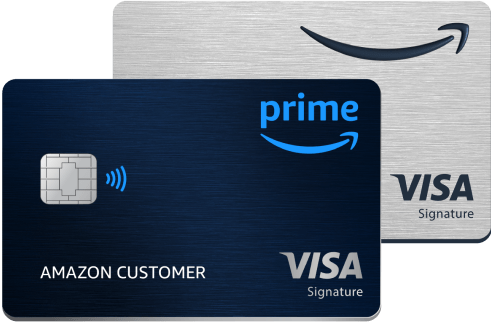Amazon Prime Visa Card Review 2024: Exceptional Rewards for Prime Members





Holly Johnson
Contributor
Holly Johnson is a freelance contributor to Newsweek’s personal finance team with a focus on credit cards and rewards, financial products and travel. Johnson has spent more than a decade covering financial and travel news and resides in Indiana with her husband and two children.






Claire Dickey
Senior Editor
Claire is a senior editor at Newsweek focused on credit cards, loans and banking. Her top priority is providing unbiased, in-depth personal finance content to ensure readers are well-equipped with knowledge when making financial decisions.
Prior to Newsweek, Claire spent five years at Bankrate as a lead credit cards editor. You can find her jogging through Austin, TX, or playing tourist in her free time.
Updated May 31, 2024 at 11:57 am
Understanding the value of cash back is simple, but valuing airline miles or points redeemable for travel requires digging a bit deeper. At Newsweek, we’ve developed a common language to talk about the value of points and miles: our valuations.
Our valuations translate points into dollars and cents in a way that reflects reality. They are based on actual data across a balance of accessible redemption options, not just the aspirational first and business class redemptions that require a PhD in miles and points to book. The upshot is that our valuations help you understand the actual value you can easily get from your miles and points.
Get a $200 Amazon Gift Card instantly upon approval exclusively for Prime members.
If you already have an Amazon Prime membership and spend a lot with the online retailer or Whole Foods, the Prime Visa is a no-brainer.
Expert Take: While you need to be an Amazon Prime member to benefit from the Prime Visa card, the 5% cash back rate at Amazon.com, Amazon Fresh and Whole Foods Market makes this card a winner for regular shoppers of these brands. Many don’t know that the card also offers 5% cash back on Chase Travel℠ purchases; 2% back at gas stations, restaurants and on local transit and commuting; and 1% back on other purchases. Numerous other benefits are automatically built in, and the lack of an annual fee makes the Amazon Prime Visa a keeper card for the long haul.
Pros
- High rewards rates at Amazon.com, Amazon Fresh, Whole Foods Market and on Chase Travel purchase
- No annual fee or foreign transaction fees
- Comes with Chase travel insurance benefits
- Flexible redemptions for rewards
Cons
- Amazon Prime membership required
- Unimpressive welcome bonus
- Can’t use rewards within Chase Ultimate Rewards portal or transfer to Chase travel partners


Vault’s Viewpoint on the Amazon Prime Visa Card
If you frequently shop at Amazon (including Amazon Fresh) or Whole Foods and you’re an Amazon Prime member already, it definitely makes sense to pick up this card and start using it for purchases that earn 5% cash back at a minimum. This earning rate is unlimited, and getting 5% cash back on purchases of household supplies, clothing, holiday gifts, groceries and everything else you buy at these stores can add up fast.
Imagine you do all of your food shopping with Amazon Fresh or Whole Foods, spending $700 per month, and you typically spend another $100 per month at Amazon.com on household items, toiletries and other things you buy. With $800 per month in spending earning 5% cash back, this card would award you with $40 in cash back per month and $480 back each year on these purchases alone. Of course, the card’s other cash back rates could help you boost your rewards haul even more.
Another benefit of this card is the flexibility of its rewards, especially since it would be easy to assume you can only redeem cash back for purchases through Amazon.com. While you can redeem your rewards for merchandise on the online shopping platform, other redemption options abound. For example, you can redeem rewards earned with the Amazon Prime Visa for cash back, gift cards, merchandise and travel through Chase.com.
The Amazon Prime Visa Card also has a surprising number of perks and benefits built in, and it doesn’t charge foreign transaction fees. These are just some of the reasons the Amazon Prime Visa is such a good deal for Amazon Prime members who are spending a lot at Amazon.com, Whole Foods or both on a regular basis.
Prime Visa Highlights
Annual fee: $0
Welcome bonus: Prime members exclusively get a $200 Amazon Gift Card instantly upon approval
Earning Rewards With the Amazon Prime Visa Card
The Amazon Prime Visa offers bonus cash back in more categories than one would think, which helps it appeal to users who want a card that rewards them for a broad range of purchases. Earning rates that apply include the following:
- Prime Card Bonus: Earn 10% back or more on a rotating selection of items and categories on Amazon.com with an eligible Prime membership
- 5% back at Amazon.com, Amazon Fresh, Whole Foods Market (in-store and online) and on Chase Travel purchases with an eligible Prime membership
- 2% back at gas stations, restaurants and on local transit and commuting (including rideshare)
- 1% back on other purchases
As noted above, the card also features a Prime Card Bonus benefit. Eligible cardholders can get 10% back or more on select items on Amazon.com. This rate takes into account the card’s standard 5% back rate on Amazon.com purchases.
Redeeming Rewards
Cardholders with the Amazon Prime Visa have the option to redeem their rewards directly for Amazon.com purchases, which is easy to do through the shopping platform. Rewards can be redeemed for Amazon purchases in any amount as well, so you don’t have to build up a specific threshold of rewards before redeeming.
Since the Amazon Prime Visa card is issued by Chase, there are other redemption options available. For example, users can redeem their Amazon Prime Visa rewards for cash back, gift cards or even travel at Chase.com.
Rates and Fees
The Amazon Prime Visa is light on typical store-branded card fees, which is one of its biggest benefits. Here’s a listing of the fees this cash back credit card does (and doesn’t) charge.
- Annual fee: $0
- Intro APR: None
- Variable APR: 19.49% to 27.49%
- Balance transfer fee: 4% (minimum $5)
- Foreign transaction fee: None
- Late payment fee: Up to $39
- Penalty APR: Up to 29.99% variable
- Cash advance fee: 4% (minimum $5)
- Cash advance APR: 29.99% variable
Amazon Prime Visa Benefits
The Amazon Prime Visa offers more benefits than you typically get with a cash back credit card, including some important travel and consumer protections. Prime Visa credit card benefits that automatically protect cardholders include the following:
- Auto rental collision damage waiver: This coverage is good for theft and collision damage for most rental cars in the United States and abroad, but it only works secondary to your own insurance.
- Baggage delay insurance: Get reimbursed for incidental expenses when your bags are delayed by at least six hours. Coverage is good for up to $100 per day for three days.
- Lost luggage reimbursement: Get up to $3,000 in coverage per passenger for luggage that is lost or damaged by a common carrier.
- Roadside dispatch: Call a hotline for help with flat tires, fuel delivery and other roadside emergencies. The hotline is free, but you’ll pay for services received.
- Travel accident insurance: Receive accidental death or dismemberment coverage of up to $500,000 when you pay for common carrier fares with the card.
- Travel and emergency assistance services: Access a hotline you can call for help with medical and legal referrals and other emergency assistance.
- Purchase protection: Qualify for purchase protection against damage or theft for items purchased with the card for up to 120 days. This benefit is good for a maximum of $500 per claim and $50,000 per account.
- Extended warranty protection: Receive an additional year of extended warranty coverage on eligible purchases that come with a manufacturer’s warranty of three years or less.
- Special financing offers: Cardholders can opt out of earning rewards on Amazon purchases and choose special 0% interest financing offers instead (on purchases of $50 or more at Amazon.com or at eligible retailers with Amazon Pay).
Who Is the Amazon Prime Visa Best For?
Because the Amazon Prime Visa card offers its best rewards rate on Amazon and Amazon Fresh purchases, Whole Foods shopping and travel booked through Chase Travel, consumers who spend a lot in any of these categories stand to benefit handsomely. The fact an Amazon Prime membership is required to have this card also makes it a solid choice for people who are already members or have considered signing up
The additional bonus rewards offered on this card can also make it a good fit for spending at restaurants, gas stations and on transit and commuting—especially among people who want to redeem their rewards for cash back or merchandise through Amazon anyway. With so many other flexible redemptions available for rewards, this card could even work for people who want to use their rewards mostly for cash back and gift cards (or even travel through Chase Travel).
Who Should Consider an Alternative to the Amazon Prime Visa?
While the Amazon Prime Visa extends a great rewards rate on Amazon, Amazon Fresh, Whole Foods and Chase Travel purchases, its lack of an intro APR means it’s only for people who plan to pay their balance in full each month. The card’s high APR can make carrying a balance on the Prime Visa card very costly, whereas there are other cash back credit cards that offer a 0% intro APR on purchases, balance transfers or both for a limited time.
Also be aware that this card is only for Amazon Prime members, so you have to have a paid membership in the program to qualify. If you don’t want to join Amazon Prime and pay the $139 membership fee each year, you’ll have to consider a different rewards credit card altogether.
How Does the Amazon Prime Visa Stack Up to Competitors?
If you’re considering the Amazon Prime Visa but want to compare it to a few other cards before you apply, there are several popular offers to keep in mind. See how the Amazon Prime Visa stacks up to the following three cards in particular, and you’ll have a better idea of the type of card you should get.
Amazon Prime Visa vs. Amazon Visa
The Amazon Visa is a version of the Prime Visa that doesn’t require an Amazon Prime membership. It has no annual fee or foreign transaction fees and features lower rewards rates overall. Essentially, signing up for this card without an Amazon Prime membership lets you earn 3% cash back at Amazon.com, Amazon Fresh, Whole Foods Market and on Chase Travel purchases; 2% back at restaurants, gas stations and on local transit and commuting (including rideshares); and 1% back on all other purchases.
This card comes with the same flexible redemption options as the Amazon Prime Visa, and it has similar insurance and consumer protections included. For example, cardholders automatically get extended warranty protection, purchase protection, baggage delay insurance, lost luggage reimbursement and more.
Similar to the Amazon Prime Visa, the Amazon Visa does not have an intro APR and charges a high variable interest rate right off the bat.
Amazon Prime Visa vs. Chase Freedom Unlimited®
The Chase Freedom Unlimited is worth considering if you want to earn cash back in everyday spending categories without an annual fee but also want an intro APR for purchases and balance transfers. The Freedom Unlimited earns 5% cash back on travel booked through Chase Travel; 5% cash back total on qualifying Lyft rides (through March 31, 2025); 3% cash back on dining at restaurants (including takeout and eligible delivery services) and drugstore purchases; and 1.5% cash back on everything else. Plus, there’s an intro offer that allows you to earn an additional 1.5% cash back on everything you buy (on up to $20,000 spent in the first year). That can be worth an additional up to $300 cash back.
While there’s no annual fee, this card does charge a foreign transaction fee when you use it for purchases abroad of 3% of the amount of each transaction in U.S. dollars. You also get access to an intro APR on both purchases and balance transfers.
Interestingly, the Chase Freedom Unlimited makes it possible to redeem rewards for Amazon purchases. Other redemption options include travel, cash back through a statement credit or direct deposit into most U.S. checking and savings accounts, gift cards and more.
Amazon Prime Visa vs. Wells Fargo Active Cash® Card
If you want to earn a flat rate of rewards on everything you buy, plus an intro APR that lets you avoid interest for more than a year, consider the Wells Fargo Active Cash. You earn 2% cash rewards on purchases, with no bonus categories to track or limits on the amount of rewards you can earn.
There’s no annual fee, and cardholders can take advantage of an intro APR on both purchases and balance transfers. That said, this card does charge a 3% foreign transaction fee when you use it for purchases outside the United States.
Rewards are also a little less flexible. For example, you can redeem rewards earned with this card for statement credits, transfers to a Wells Fargo bank account, payments on an eligible Wells Fargo loan, cash back at an ATM with a Wells Fargo debit card or gift cards.
Is the Amazon Prime Visa Worth It?
The Amazon Prime Visa can definitely be worth it as a standalone cash back card if you spend a lot with Amazon and Whole Foods, but it’s also an excellent companion card if your goal is maximizing rewards on everything you buy. For example, you could easily use the Prime Visa for all of your Amazon, Amazon Fresh and Whole Foods shopping to earn 5% cash back before switching to other rewards or travel credit cards to earn an optimal amount of rewards on other purchases you make.
Whatever you do, make sure you can pay off your balance in full each month. If you wind up carrying a balance and paying interest at this card’s high variable APR, the rewards you earn won’t be worth it.
Frequently Asked Questions
How Much Is Amazon Prime Membership?
Amazon Prime membership costs $139 annually. You can also break up the cost of membership by paying $14.99 per month. If you’re a student, you can qualify for a reduced membership fee of $69 per year or $7.49 per month.
What Credit Score Is Required for the Amazon Prime Visa?
The Amazon Prime Visa is geared toward consumers with good to excellent credit. This includes FICO Scores of 670 and up.
What Is the Credit Limit on the Amazon Prime Visa?
According to Chase, the minimum credit limit on the Amazon Prime Visa starts at $500. However, Chase does not list a maximum credit limit for this card.
Editorial Note: Opinions expressed here are author’s alone, not those of any bank, credit card issuer, hotel, airline or other entity. This content has not been reviewed, approved or otherwise endorsed by any of the entities included within the post. We may earn a commission from partner links on Newsweek, but commissions do not affect our editors’ opinions or evaluations.




Holly Johnson
Contributor
Holly Johnson is a freelance contributor to Newsweek’s personal finance team with a focus on credit cards and rewards, financial products and travel. Johnson has spent more than a decade covering financial and travel news and resides in Indiana with her husband and two children.
